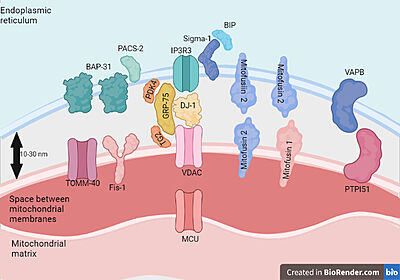User:Maria Carolina Boer Copstein/Sandbox 1
From Proteopedia
| Line 10: | Line 10: | ||
== Relevance == | == Relevance == | ||
| - | As VDAC1 is a mitochondrial membrane protein, it is involved in cell metabolism in addition to mitochondrial-dependent apoptosis processes and regulates calcium homeostasis and oxidative stress.VDAC1 is highly Ca2+-permeable and modulates Ca2+ access to the mitochondrial intermembrane space. Intramitochondrial Ca2+ controls energy metabolism by enhancing the rate of NADH production via modulating critical enzymes in the tricarboxylic acid cycle and fatty acid oxidation. Mitochondrial [Ca2+] is regarded as an important determinant of cell sensitivity to apoptotic stimuli and was proposed to act as a “priming signal,” sensitizing the organelle and promoting the release of pro-apoptotic proteins.Intracellular Ca2+concentration ([Ca2+]i) regulates a number of cellular and intercellular events, such as the cell cycle, proliferation, gene transcription, and cell death pathways, as well as processes like muscle contractility and neuronal processing and transmission | + | As VDAC1 is a mitochondrial membrane protein, it is involved in cell metabolism in addition to mitochondrial-dependent apoptosis processes and regulates calcium homeostasis and oxidative stress.VDAC1 is highly Ca2+-permeable and modulates Ca2+ access to the mitochondrial intermembrane space. Intramitochondrial Ca2+ controls energy metabolism by enhancing the rate of NADH production via modulating critical enzymes in the tricarboxylic acid cycle and fatty acid oxidation. Mitochondrial [Ca2+] is regarded as an important determinant of cell sensitivity to apoptotic stimuli and was proposed to act as a “priming signal,” sensitizing the organelle and promoting the release of pro-apoptotic proteins.Intracellular Ca2+concentration ([Ca2+]i) regulates a number of cellular and intercellular events, such as the cell cycle, proliferation, gene transcription, and cell death pathways, as well as processes like muscle contractility and neuronal processing and transmission. The alteration of Ca2+ homeostasis is closely related with various cancer hallmarks, including proliferation, migration, angiogenesis, invasion abilities, and resistance to cell death.VDAC1 has also been recognized as a key protein in mitochondria-mediated apo-ptosis, contributing to the release of apoptotic proteins located in the inter-membranal space (IMS) andregulating apoptosis via association with pro- and anti-apoptotic members of the Bcl-2 family of pro-teins and hexokinase. |
Revision as of 08:29, 13 December 2021
| |||||||||||
References
Magri Andrea ,Messina Angela, “Interactions of VDAC with Proteins Involved in Neurodegenerative Aggregation: An Opportunity for Advancement on Therapeutic Molecules”, Current Medicinal Chemistry 2017; 24(40) . https://doi.org/10.2174/0929867324666170601073920
Hosaka T, Okazaki M, Kimura-Someya T, et al. Crystal structural characterization reveals novel oligomeric interactions of human voltage-dependent anion channel 1. Protein Sci. 2017;26(9):1749-1758. https://doi.org/10.3390/antiox9121218
Pittalà, M.G.G.; Reina, S.; Cubisino, S.A.M.; Cucina, A.; Formicola, B.; Cunsolo, V.; Foti, S.; Saletti, R.; Messina, A. Post-Translational Modification Analysis of VDAC1 in ALS-SOD1 Model Cells Reveals Specific Asparagine and Glutamine Deamidation. Antioxidants 2020, 9, 1218. https://doi.org/10.3390/antiox9121218

![Alterations in VDAC1 observed in ALS[2].](/wiki/images/thumb/e/e1/ALS_dysfunctions.png/500px-ALS_dysfunctions.png)
